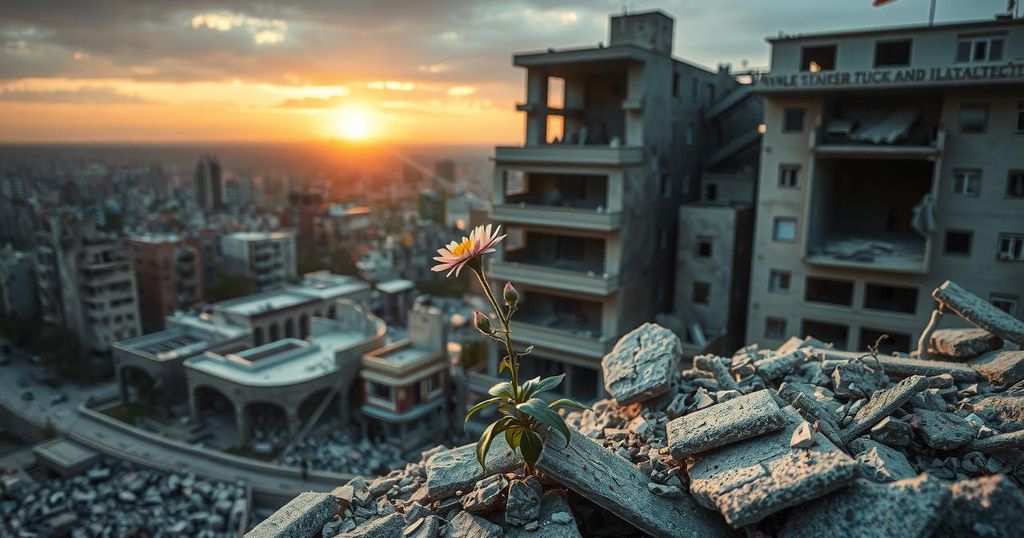The BBC visited Goma, DR Congo, recently captured by M23 rebels following intense violence resulting in hundreds of deaths and injuries. Despite initial normalcy, checkpoints revealed the insurgents’ control, and local hospitals struggled to manage a surge of wounded. Resilience exists among residents, yet fears remain concerning future security and continued advances by the rebels.
Upon entering Goma, located in the eastern Democratic Republic of Congo (DR Congo), it initially appeared to be a bustling city rather than a conflict zone. Streets were filled with residents heading to work, vendors selling goods, and taxi drivers seeking fares. However, the control exerted by the M23 rebel group quickly became evident at a checkpoint manned by armed fighters, who halted my vehicle and initiated a brief inquiry before permitting us to proceed into the city.
The M23 rebels recently seized Goma, a city with a population of nearly two million, following a rapid military advance that resulted in significant casualties. According to reports from the United Nations and Congolese officials, at least 700 people were killed and nearly 3,000 were injured during confrontations between rebel forces and the Congolese army.
The M23, primarily composed of ethnic Tutsis, claims to be advocating for the rights of minorities, while the Congolese government accuses them of pursuing control over the region’s extensive mineral resources. Upon entering Goma, it was apparent that these rebels had established a presence and faced no resistance from local authorities.
My visit to a local hospital revealed the dire situation as wounded individuals flooded in, echoing cries of pain reverberated through the hallways. I encountered Dr. Nathaniel Cirho, who was himself injured by shrapnel during an explosion. He recounted the tragic loss of a 65-year-old neighbor who succumbed to injuries post-surgery, underscoring the grim reality facing Goma.
Other patients displayed severe injuries, with one elderly woman describing how she had removed a bullet from her own arm after being shot during a nearby conflict. Despite surviving on her own for days with limited assistance, she sought better care at a private hospital after being escorted there by the M23 fighters.
The hospital was overwhelmed, receiving hundreds of injured individuals, a doctor reported. During the initial surge following the outbreak of fighting, they treated 315 patients on one day alone, but now, the number of injured had exceeded 700, with severe cases involving gunshot wounds to various body parts being commonplace.
Beyond the hospital, the city exhibited signs of a tenuous calm, with some businesses reopening while others remained shuttered due to fear of further violence. Residents still experienced the aftermath of combat, exemplified by bullet-marked vehicles lying neglected in the streets, as various establishments gradually resumed operations.
Despite the waning gunfire, there was a palpable air of apprehension among the populace. Sammy Matabishi, a local shop owner, expressed concern over ongoing tensions, noting that many traders had fled to other regions. He lamented the declining numbers of customers and the difficulties in importing goods.
While some residents appeared resigned to the presence of the M23, the rebels actively reinforced their dominance throughout Goma, having eliminated existing military leadership. I observed the absence of Congolese soldiers during my time in the city, with militants patrolling the streets and occupying critical infrastructure formerly held by the Congolese authorities.
The Congolese government disclaims the rebels’ claims to control Goma and accuses them of unlawful occupation, asserting plans for reclamation of lost territories. Rwanda’s involvement remains a contentious issue; once consistently denied, the narrative has shifted towards emphasizing security concerns in light of rebels operating near its borders.
Currently, reports indicate that the M23 is advancing southwards towards Bukavu, the capital of South Kivu, with aspirations of moving further toward Kinshasa, the national capital. The situation in Goma serves as a harbinger of potential future conditions for many Congolese should the M23 continue to exert their influence across the region.
The conflict in the Democratic Republic of Congo has persisted through decades of violence often fueled by ethnic tensions and struggles for control of the region’s vast natural resources. The M23 rebel group, primarily composed of ethnic Tutsis, emerged amidst these complexities, claiming rights for minority groups while facing accusations of being backed by Rwanda in their quest for power. Recent events, particularly the capture of Goma, highlight the dire humanitarian impact of the ongoing instability and the urgency of addressing the security crisis affecting civilian populations.
The situation in Goma illustrates the acute humanitarian crisis resulting from the conflict in eastern DR Congo, revealed by the significant influx of injured individuals and the overwhelming burden on medical facilities. The M23’s control over the city has led to widespread fear among residents, raising concerns about potential further advances by the rebels. The international community must continue to monitor developments closely, as the implications extend beyond Goma into the broader regional stability.
Original Source: www.bbc.co.uk






